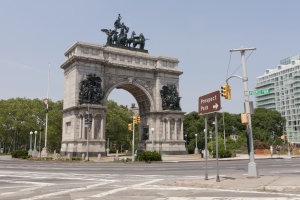Some local leaders are up in arms about a cache of unexplodedmunitions discovered in Gravesend Bay near the Brooklyn tower ofthe Verrazano Bridge – and although the U.S. Coast Guard hasrecently barred boats from passing through the littered area, manystill insist that the explosives should be removed.
A commercial diver, Gene Ritter, discovered the munitions – athree-inch shell and 1,500 20-millimeter rounds – last Octoberduring a search for artifacts in the area formerly known as FortLafayette, an island destroyed in 1960 in preparation for thebridge construction. Ritter, as well as industry experts, believethe munitions broke free of a barge on the USS Bennington whichoverturned and drifted to the Rockaways during a 1954 storm.The safe zone around the munitions, temporarily established inJanuary and made official on June 30, keeps all boats, divers andfishermen at least 70 yards from the base of the bridge until theexplosives are taken away – but some leaders worry that this willfurther delay the removal of the ammo.Congressmember Michael Grimm of Brooklyn and Staten Island wrote toincoming Defense Secretary, Leon Panetta, insisting that theDepartment of Defense establish a firm timeline for removal of thefirearms.The establishment of this safe area clearly underscores the threatthese munitions may pose to those traveling along or diving thesewaters near the Verrazano-Narrows Bridge, Grimm wrote. And thus Irespectfully request that the Department of Defense and itssubordinate agencies work quickly to establish a firm timeline forthe prompt, safe removal of these explosives from GravesendBay.The Army Corps of Engineers, which holds responsibility for theremoval of the munitions, will be holding a preliminary assessmentof the situation, according to Gregory J. Goepfert, the projectmanager of the Army Corps New York district.We have to assess if there really is a hazard and determine whatthe extent of the situation is, Goepfert said. That doesn’tdiscount the possibility of removal, if the assessment shows thatthat is indeed necessary.He also pointed out that two steps must be taken before themunitions are removed: the Corps must first review availabledocumentation regarding the incident that may have caused themunitions to be deposited, and then send divers down to take lookat what the extent of those issues may be for those munitions inthat area.Assemblymember William Colton is also concerned about thesemunitions – but he is especially apprehensive that other munitionsare scattered around the bay that have not been found.The barge that broke loose with that one incident was found upsidedown in Rockaway Beach with no shells on it, Colton said. Thatparticular area was used to transport munitions for 100 years. Myconcern is that we still have to be concerned about other munitionshells that are in the ocean bottom.Colton believes that the munitions will not detonate as long asthey are left undisturbed, but he notes that circulating plans todredge in a part of Gravesend Bay adjacent to the safe zone couldcreate a massive problem.Ida Sanoff, the chairperson of the Natural Resources ProtectiveAssociation, isn’t concerned about one dredging proposal that aimsto deepen a shipping channel in the area, the Ambrose FederalNavigation Channel, which extends from the Verrazano-NarrowsBridge, flows into the Anchorage Channel, and moves in a southeastdirection toward deep water in the Atlantic Ocean. She explainedthat this process should not cause any problems with the nearbymunitions, because of the precautionary measures involved in theprocedure.There is always a chance that the tides have carried some of themunitions, so [the dredgers] are going to be using a screen toprevent anything from piling up into pipelines as they dredge,Sanoff said.However, she was less optimistic about another proposal to dredgethe bay to make way for a waste transfer station on Shore Parkwayand Bay 41st Street – where garbage will be containerized beforebeing shipped to other states for landfilling – which she pointedout would require an entirely different procedure that would notuse the screen as a buffer. The Department of Sanitation, which isresponsible for developing the station, must obtain a permit fromthe Army Corps as well as the state before embarking on thedredging project.The department is keeping in mind the potential dangers of themunitions that may have scattered into this proposed dredgingsite.The department has previously addressed these concerns, saidMatthew LiPani, a spokesperson for the department.Leave a Reply
You must be logged in to post a comment.
 Generally Speaking: Bay Ridge resident named Brooklyn surrogate, Memorial Day Parade-ers honored
Generally Speaking: Bay Ridge resident named Brooklyn surrogate, Memorial Day Parade-ers honored  Captain America celebrates 75th birthday with statue in Prospect Park
Captain America celebrates 75th birthday with statue in Prospect Park